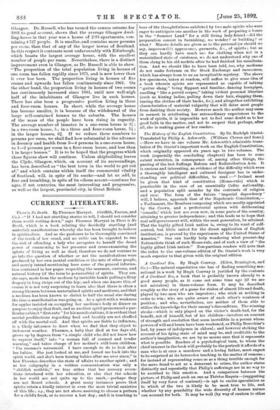THE TRANSFORMATION OF GLASGOW.* LAST year's census demonstrated Glasgow to
be without any rival for the position of second city in the United King- dom. Its population in April was ascertained to be 565,714. During the year an Act was passed, which came into opera- tion last November, which increased its boundaries, and, in consequence, its population to the extent of 91,232 persons. Glasgow is, therefore, a city of 654,946 inhabitants, while the populations of Liverpool, Manchester, and Birmingham are respectively 517,951, 505,343, and 429,171. Mr. Nicol, in the remarkably able and well-arranged treatise—for so it ought to be styled—he has produced on the progress during the past few years of the city of which, as Chamberlain, he is in a sense the custodian, further shows, by including the popu- lation of the burghs that are really portion of the Glasgow area, and also the " number dependent on Glasgow, but living beyond suburban limits," and the number temporarily at coast and country during Easter holidays, when the census was taken, that this second city in the Kingdom contains, in all, 814,411 inhabitants. The population of Glasgow is, therefore, almost identical with that of London a hundred years ago, at which time its own, inclusive of suburbs, was 66,758. This rise suffi- ciently shows how very rapid has been the progress of Glasgow; bow great it has been may be gathered from the other statis- tical fact that in 1708, immediately after the Union, its popu- lation was 12,766. At that time it was smaller than Edinburgh ; now, the population of what Lord Salisbury has diplomatically termed " the capital of the other side of Scotland," is 261,261. The rental of the old city of Glasgow has risen from £2,126,324 in 1870-71, to £3,455,510 in 1890-91. It is farther calculated that the rental of the extended city in 1891-92 was £4,046,726, or almost exactly double that of Edinburgh. The story which Mr. Nicol has to tell of Glasgow is one not so much of ordinary British increase, as of transformation on an American scale.
Dr. Russell, the Medical Officer of Health for Glasgow, traverses, in his pamphlet which we have bracketed with Mr. Nicol's volume, much the same ground as his brother-official. On certain important points he is more detailed. Glasgow is equal (to say the least of it) to any other city in the United Kingdom, or, for that matter, in the United States, in point of municipal management, lighting, sanitation, and the general energy of its citizens. But it has notoriously one very black spot,—the insufficient accommodation it affords its inhabi- tants. Mr. Bright once threw the almost lurid light of his eloquence on its one-roomed and two-roomed houses. This is still the blemish on the fair social reputation of
• (1.) Vital, Social, and Economic Statistics of the City of Glasgow, 1885-1891; with Observations Theron. By James Nicol, City Chamberlain. Glasgow : James Maclehose and Sons. 1591.—(2.) Old Glasgow, and its Statistical Divisions as at 6th April, 1891. Greater Glasgow, as Constituted by the City of Glasgow Act, 1891. By James B. Russell, M.D., LL.D., Medical Officer of Health. Glasgow. Dr. Russell, who has turned the census returns for 1891 to good account, shows that the average Glasgow dwel- ling-house in that year was a house of 2.33 apartments, con- taining 4.727 people. It is smaller, and contains more persons per room, than that of any of the larger towns of Scotland. In this respect it contrasts most unfavourably with Edinburgh, which boasts the largest average house, with the smallest number of people per room. Nevertheless, there is a distinct improvement even in Glasgow, as Dr. Russell is able to show. "The proportion of the total population living in houses of one room has fallen rapidly since 1871, and is now lower than it ever has been. The proportion living in houses of five rooms and upwards has fallen continuously since 1861. On the other hand, the proportion living in houses of two rooms has continuously increased since 1861, until now well-nigh half of the inhabitants of Glasgow live in such houses. There has also been a progressive portion living in three and four-room houses. In short, while the average house has become smaller, it is because of the withdrawal of the large self-contained houses to the suburbs. The houses of the mass of the people have been rising in capacity. The average number of inmates in a one-room house is 31; in a two-room house, 5 ; in a three and four-room house, 51; in the larger houses, Q. If we reduce these numbers to persons per room, we shall find how substantial is the advance in decency and health from 3-4 persons in a one-room house, to 1-2 persons per room in a four-room house, and less than 1 in larger houses." It is to be hoped that the progress which these figures show will continue. Unless shipbuilding leaves the Clyde, Glasgow, which, on account of its surroundings, has been described as "the best town in the world to get out of," and which contains within itself the commercial vitality of Scotland, will, in spite of its smoke—and let us add, in fear and trembling, in spite of its odious accent—continne for ages, if not centuries, the most interesting and progressive, as well as the largest, provincial city, in Great Britain.



































 Previous page
Previous page